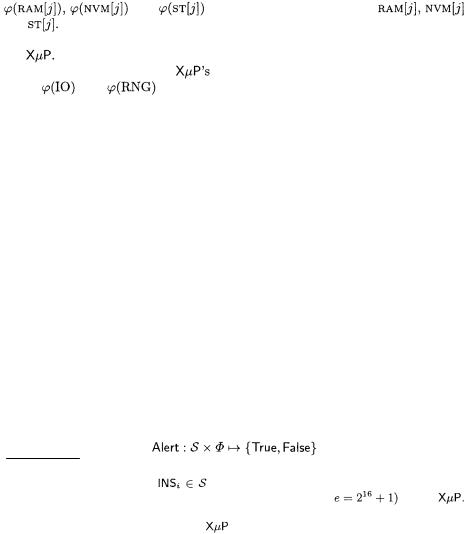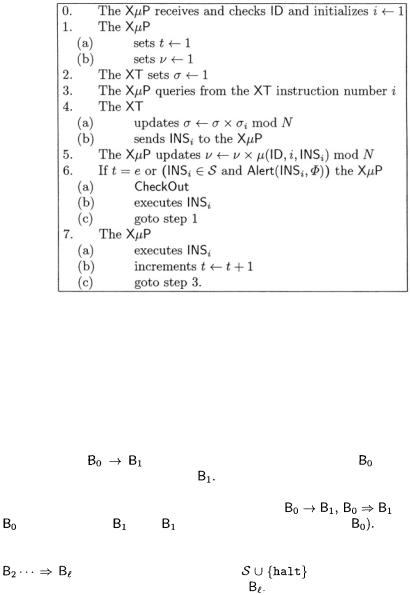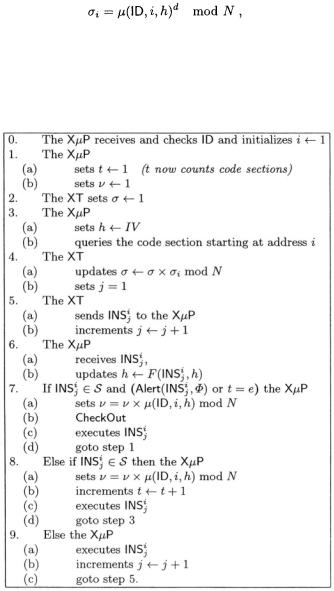
Joye M.Cryptographic hardware and embedded systems.2005
.pdf




450 B. Chevallier-Mames et al.
This protocol presents the advantage of being far less time consuming, because the number of CheckOuts (and updates of  is considerably reduced. The formats under which the code can be stored in the XT are diverse. The simplest of these consists in representing P as the list of all its signed code sections
is considerably reduced. The formats under which the code can be stored in the XT are diverse. The simplest of these consists in representing P as the list of all its signed code sections  Whatever the file format used in conjunction with our protocol is, the term authenticated program designates a program augmented with its signature material
Whatever the file format used in conjunction with our protocol is, the term authenticated program designates a program augmented with its signature material  Thus, our protocols actually execute authenticated programs. A program is converted into an authenticated executable file via a specific compilation phase involving both code processing and signature generations.
Thus, our protocols actually execute authenticated programs. A program is converted into an authenticated executable file via a specific compilation phase involving both code processing and signature generations.
6Security Analysis
What we provide in this section is a formal proof that the protocols described above are secure. The security proof shall have two ingredients: a well-defined security model describing an adversary’s goal and resources, and a reduction from some complexity-theoretic hard problem. Rather than rigourously introducing the numerous notions our security model is based upon (which the reader may find in [6], as well as the fully detailed reductions), we give here a high-level description of our security analysis.
THE SECURITY MODEL. We assume the existence of three parties in the game:
a |
code issuer |
that compiles |
XJVML programs |
into |
authenticated |
exe- |
|
cutable files with the help of the signing key |
|
|
|
||||
an |
that |
follows the communication |
protocol given |
in Section 4 |
and |
||
contains the verification key |
matching |
The |
also possesses |
||||
some cryptographic private key material |
stored in its NVM, |
|
|||||
an |
attacker |
willing to access |
using means that are discussed below. |
|
|||
ADVERSARIAL GOALS. Depending on the role played by the  cryptographic key
cryptographic key  the adversary’s goals might be of different nature. Of course, inferring information about
the adversary’s goals might be of different nature. Of course, inferring information about (worse,recovering
(worse,recovering  completely) comes immediately to one’s mind, but there could also be weaker (somewhat easier) ways of having access to
completely) comes immediately to one’s mind, but there could also be weaker (somewhat easier) ways of having access to  For instance if
For instance if  is a symmetric encryption key,
is a symmetric encryption key,  might try to decrypt ciphertexts encrypted under
might try to decrypt ciphertexts encrypted under  Similarly, if it is a public-key signature key,
Similarly, if it is a public-key signature key,  could attempt to rely on the protocol engaged with the
could attempt to rely on the protocol engaged with the  to help forging signatures in a way or an other. More exotically, the adversary could try to hijack the key
to help forging signatures in a way or an other. More exotically, the adversary could try to hijack the key  e.g. to use it (or a part of it thereof) as an AES key whereas
e.g. to use it (or a part of it thereof) as an AES key whereas  was intended to be employed some other way.
was intended to be employed some other way.  goal in this case is a bit more intricate to capture, but we see no reason why we should prohibit that kind of scenario in our security model. Third, the adversary may attempt to modify
goal in this case is a bit more intricate to capture, but we see no reason why we should prohibit that kind of scenario in our security model. Third, the adversary may attempt to modify  thereby opening the door to fault attacks [2,3].
thereby opening the door to fault attacks [2,3].
THE ATTACK SCENARIO. Parties behave as follows. The  crafts polynomially many authenticated programs of polynomially bounded size and publishes them.
crafts polynomially many authenticated programs of polynomially bounded size and publishes them.
TEAM LinG





 is an accumulated product of
is an accumulated product of  padded instructions
padded instructions  Loosely speaking, both parties
Loosely speaking, both parties  and XT update their own security buffers
and XT update their own security buffers  and
and  which compatibility (in the sense of
which compatibility (in the sense of  is checked before executing any security-critical instruction. Note that a verification is also triggered when exactly
is checked before executing any security-critical instruction. Note that a verification is also triggered when exactly  instructions are aggregated in
instructions are aggregated in 
 (secure but suboptimal)
(secure but suboptimal) are frequently used. For instance,
are frequently used. For instance,  would incessantly trigger the relatively expensive
would incessantly trigger the relatively expensive values. Transfer instructions simply transfer the privacy bit of their variable (
values. Transfer instructions simply transfer the privacy bit of their variable ( and
and  where
where  denotes the stack pointer and
denotes the stack pointer and  the topmost stack element). The rule we apply to arithmetical and logical instructions is
the topmost stack element). The rule we apply to arithmetical and logical instructions is  denotes the set of all privacy bits
denotes the set of all privacy bits 
 evaluates as True when a CheckOut is to be invoked. We hence twitch our protocol as now shown on Figure 3.
evaluates as True when a CheckOut is to be invoked. We hence twitch our protocol as now shown on Figure 3.
 In a code section, the control flow is deterministic
In a code section, the control flow is deterministic  is:
is: where
where are the successive instructions in S. Here,
are the successive instructions in S. Here, 
 and
and  where
where  is
is  of
of  stipulating by convention that executing each instruction takes one step and that all transmissions (instruction addresses, instructions, signatures and IO data) are instantaneous.
stipulating by convention that executing each instruction takes one step and that all transmissions (instruction addresses, instructions, signatures and IO data) are instantaneous. is
is  against existential forgery under a known message attack, then Protocol 1 is
against existential forgery under a known message attack, then Protocol 1 is  for
for 
 outputting a valid forgery is equivalent to extracting
outputting a valid forgery is equivalent to extracting  roots modulo
roots modulo  is a full domain hash function, then Protocol 1 is secure under the RSA assumption in the random oracle model.
is a full domain hash function, then Protocol 1 is secure under the RSA assumption in the random oracle model. is
is  against existential forgery under a known message attack, then Protocol 2 is
against existential forgery under a known message attack, then Protocol 2 is 
 for
for 
 and
and  is seen as a random oracle, a security result similar to Corollary 1 can be obtained for Protocol 2. However, a bad choice for
is seen as a random oracle, a security result similar to Corollary 1 can be obtained for Protocol 2. However, a bad choice for  to easily find collisions over
to easily find collisions over  via collisions over
via collisions over  where
where  is a full-domain hash function seen as a random oracle. Then Protocol 2 is secure under the RSA assumption and the collision-intractability of H.
is a full-domain hash function seen as a random oracle. Then Protocol 2 is secure under the RSA assumption and the collision-intractability of H. with messages of her choosing, a trivial attack consists in obtaining the signature
with messages of her choosing, a trivial attack consists in obtaining the signature and the singlesection program
and the singlesection program  the value 17 being purely illustrative here
the value 17 being purely illustrative here that either instructs the
that either instructs the  to replace its old ID by a new one and stop accepting older version programs or allow the execution of new or old code (each at a time,
to replace its old ID by a new one and stop accepting older version programs or allow the execution of new or old code (each at a time,  Obviously, morphologic information about the algorithm will leak out to some extent (loop structure
Obviously, morphologic information about the algorithm will leak out to some extent (loop structure  can very easily support several applications provided that the sum of the NVM spaces used by these applications does not exceed the
can very easily support several applications provided that the sum of the NVM spaces used by these applications does not exceed the  total NVM capacity and that these NVM spaces are properly firewalled. From the user’s perspective the
total NVM capacity and that these NVM spaces are properly firewalled. From the user’s perspective the  is tantamount to a key ring carrying all the secrets (credentials) used by the applications that the user interacts with but
is tantamount to a key ring carrying all the secrets (credentials) used by the applications that the user interacts with but  integers theoretically requires
integers theoretically requires  operations, multiplying a random
operations, multiplying a random  by
by  may require only
may require only  operations when
operations when  is adequately chosen. Independently, an adequate usage of RAM counters allows to decrease the value of
is adequately chosen. Independently, an adequate usage of RAM counters allows to decrease the value of  without sensibly increasing the expected number of CheckOut on the average.
without sensibly increasing the expected number of CheckOut on the average.
 and the XT. Evaluating transmission performances for a popular standard, the Universal Serial Bus (USB)
and the XT. Evaluating transmission performances for a popular standard, the Universal Serial Bus (USB) working at 390 KHz; when parallel execution and look-ahead transmission take place, one gets a 32-bit machine running at 780 KHz. An 8-bit USB interface leads to 830 KHz. There is no doubt that these figures can be greatly improved.
working at 390 KHz; when parallel execution and look-ahead transmission take place, one gets a 32-bit machine running at 780 KHz. An 8-bit USB interface leads to 830 KHz. There is no doubt that these figures can be greatly improved. to program
to program  or the devising of faster execution protocols.
or the devising of faster execution protocols.